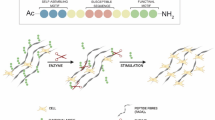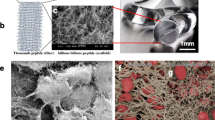Abstract
Peptides were genetically produced that were composed of two or three repeats of the self-assembling peptide RADA16 (RADARADARADARADA), and referred to as RADA16 × 2 and RADA16 × 3, respectively. These peptides were expressed as fusion proteins that retained the activity of the fusion partner protein. The expressed peptides exhibited both fibril formation and the ability to support cell adhesive activity. Moreover, hydrogels formed by the peptides via the addition of a medium provided a three-dimensional environment for cell proliferation.
Similar content being viewed by others
Log in or create a free account to read this content
Gain free access to this article, as well as selected content from this journal and more on nature.com
or
References
Langer, R. & Vacanti, J. P. Tissue engineering. Science 260, 920–926 (1993).
Barrera, D. A., Zylstra, E., Lansbury, P. T. & Langer, R. Synthesis and RGD peptide modification of a new biodegradable copolymer –poly (lactic acid-co-lysine). J. Am. Chem. Soc. 115, 11010–11011 (1993).
Betre, H., Setton, L. A., Meyer, D. E. & Chilkoti, A. Characterization of a genetically engineered elastin-like polypeptide for cartilaginous tissue repair. Biomacromolecules 3, 910–916 (2002).
Halstenberg, S., Panitch, A., Rizzi, S., Hall, H. & Hubbell, J. A. Biologically engineered protein-graft-poly(ethylene glycol) hydrogels: a cell adhesive and plasm in-degradable biosynthetic material for tissue repair. Biomacromolecules 3, 710–723 (2002).
Nagaoka, M., Jiang, H. L., Hoshiba, T., Akaike, T. & Cho, C. S. Application of recombinant fusion proteins for tissue engineering. Ann. Biomed. Eng. 38, 683–693 (2010).
Kobatake, E., Onoda, K., Yanagida, Y. & Aizawa, M. Design and gene engineering synthesis of an extremely thermostable protein with biological activity. Biomacromolecules 1, 382–386 (2000).
Elloumi, I., Kobayashi, R., Funabashi, H., Mie, M. & Kobatake, E. Construction of epidermal growth factor fusion protein with cell adhesive activity. Biomaterials 27, 3451–3458 (2006).
Nakamura, M., Mie, M., Mihara, H. & Kobatake, E. Construction of multi-functional extracellular matrix proteins that promote tube formation of endothelial cells. Biomaterials 29, 2977–2986 (2008).
Nakamura, M., Mie, M., Mihara, H. & Kobatake, E. Construction of a multi-functional extracellular matrix protein that increases number of N1E-115 neuroblast cells having neurites. J. Biomed. Mater. Res. B Appl. Biomater. 91, 425–432 (2009).
Nakamura, M., Yamaguchi, K., Mie, M., Akita, K. & Kobatake, E. Promotion of angiogenesis by an artificial extracellular matrix protein containing the laminin-1-derived IKVAV sequence. Bioconjug. Chem. 20, 1759–1764 (2009).
Grant, D. S., Kinsella, J. L., Fridman, R., Auerbach, R., Piasecki, B. A., Yamada, Y., Zain, M. & Kleinman, H. K. Interaction of endothelial-cells with a laminin-a chain peptide (SIKVAV) in vitro and induction of angiogenic behavior in vivo. J. Cell. Physiol. 153, 614–625 (1992).
Tashiro, K., Sephel, G. C., Weeks, B., Sasaki, M., Martin, G. R., Kleinman, H. K. & Yamada, Y. A synthetic peptide containing the IKVAV sequence from the a-chain of laminin mediates cell attachment, migration, and neurite outgrowth. J. Biol. Chem. 264, 16174–16182 (1989).
Lee, J., Macosko, C. W. & Urry, D. W. Elastomeric polypentapeptides cross-linked into matrixes and fibers. Biomacromolecules 2, 170–179 (2001).
Zhang, S. G., Holmes, T. C., Dipersio, C. M., Hynes, R. O., Su, X. & Rich, A. Self-complementary oligopeptide matrices support mammalian-cell attachment. Biomaterials 16, 1385–1393 (1995).
Zhang, S. G., Lockshin, C., Herbert, A., Winter, E. & Rich, A. Zuotin, a putative Z-DNA binding-protein in Saccharomyces-cerevisiae. EMBO J. 11, 3787–3796 (1992).
Holmes, T. C., de Lacalle, S., Su, X., Liu, G. S., Rich, A. & Zhang, S. G. Extensive neurite outgrowth and active synapse formation on self-assembling peptide scaffolds. Proc. Natl. Acad. Sci. USA 97, 6728–6733 (2000).
Gelain, F., Horii, A. & Zhang, S. G. Designer self-assembling peptide scaffolds for 3-D tissue cell cultures and regenerative medicine. Macro. Bioscience 7, 544–551 (2007).
Narmoneva, D. A., Vukmirovic, R., Davis, M. E., Kamm, R. D. & Lee, R. T. Endothelial cells promote cardiac myocyte survival and spatial reorganization - implications for cardiac regeneration. Circulation 110, 962–968 (2004).
Puchtler, H. & Sweat, F. Congo red as a stain for fluorescence microscopy of amyloid. J. Histochem. Cytochem. 13, 693–694 (1965).
Klunk, W. E., Pettegrew, J. W. & Abraham, D. J. Quantitative-evaluation of congo red binding to amyloid-like proteins with a beta-pleated sheet conformation. J. Histochem. Cytochem. 37, 1273–1281 (1989).
Acknowledgements
We are grateful to Ms Keiko Yamamichi from the Technical Department of the Tokyo Institute of Technology for technical support with the transmission electron microscope imaging.
Author information
Authors and Affiliations
Corresponding author
Rights and permissions
About this article
Cite this article
Mie, M., Oomuro, M. & Kobatake, E. Hydrogel scaffolds composed of genetically synthesized self-assembling peptides for three-dimensional cell culture. Polym J 45, 504–508 (2013). https://doi.org/10.1038/pj.2012.216
Received:
Revised:
Accepted:
Published:
Issue date:
DOI: https://doi.org/10.1038/pj.2012.216



